DeFi Trends for 2024
Seven DeFi trends for investors to watch in 2024 include: Perpetual LP pools, intents based architecture, the points and airdrop meta, liquid staking protocols, cross chain bridging, real world assets, Bitcoin Layer 2s and other DeFi developments on the Bitcoin network, and prediction markets.
Key Takeaways
-
Total Value Locked (TVL) has more than doubled since its low of $36.59 billion in October 2023, and is currently at over $90 billion.
-
Trends to watch include:
-
Perpetual LP pools that offer real yield
-
Intents based architecture that lets users specify desired outcomes without needing users to define every aspect of their transactions
-
Points and airdrops to stimulate user participation and liquidity
-
Liquid staking and restaking, which lets stakers retain liquidity while assets are locked for staking
-
Cross chain bridging to enable interoperability and asset transfers across different blockchain networks
-
Real world assets (RWA) that offer users a safe(r) haven to store assets in crypto by providing stable yields
-
Developments on the Bitcoin network to overcome the previous contraints of Bitcoin's scripting capabilities, enabling the creation of dApps on Bitcoin.
-
Prediction markets, which lets users trade and speculate on the outcome of future events.
-
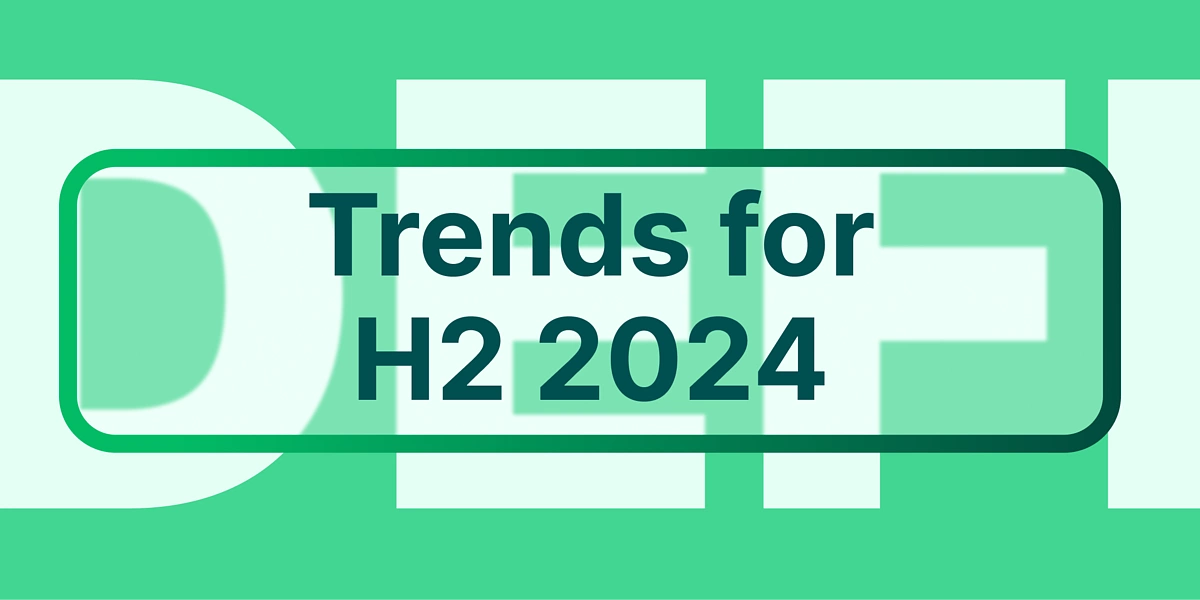
Since its inception in 2020, Decentralized Finance (DeFi) is arguably the biggest innovation in the cryptocurrency space. DeFi boasts an alternate approach to financial services, removing intermediaries like banks and brokers, and offers direct services such as lending, trading, and investments in a peer-to-peer, open, and transparent manner.
The total value locked (TVL) in DeFi is now at $91.76 billion, which is a 53.49% drop from its peak of $176.25 billion in October 2022. While this might seem like a big decline, there's been a noticeable turnaround in the fourth quarter of 2023. The TVL has more than doubled from its low of $36.59 billion in October 2023, showing a clear shift in market sentiment.
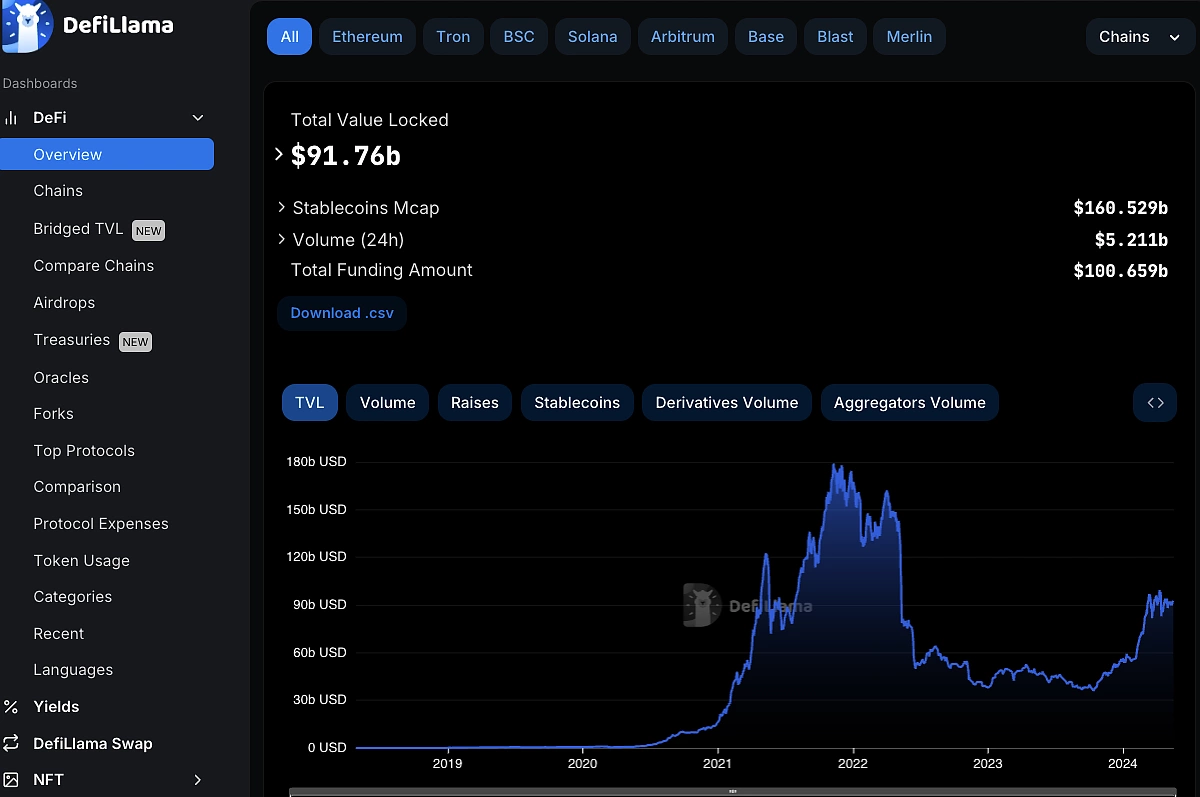
With 2024 shaping up as a recovery year for cryptocurrencies, DeFi trends are also gaining momentum, both in terms of protocol growth and new capital inflows. Today, we're diving into seven DeFi trends you should keep a close eye on for the second half of 2024.
1. Perpetual LP Pools Gains Popularity in 2024 as Traders Look to Leverage Up
The first trend may be an unsexy one as it is a concept the crypto market is well accustomed to; however, it may just be the most reliable as it capitalizes on ‘real yield’.
Liquidity Pools (LP) are smart contracts to lock up tokens to provide liquidity. They are often used by decentralized exchanges and lending protocols to facilitate token swaps and borrowing and lending activities, therefore playing an important role in DeFi. They aim to garner sufficient liquidity to reduce slippage, especially when dealing with stablecoins and other highly liquid assets.
While early LP Pools were built to facilitate peer-to-peer trading, some protocols have evolved this concept towards “trading against the house” instead, in particular for perpetual trading. This reduces the need for liquidity providers to pay close attention to their LP positions, and also enables broader “pooling” of yield as the liquidity provider provides liquidity for the “house”. We look at two perpetual-based LP pools you could take advantage of earning yields ranging from 30% to 100% APY in the next half of 2024.
GMX
GMX is a decentralized exchange (DEX) that specializes in perpetual futures trading, operating on both Arbitrum and Avalanche networks. This platform allows users to trade cryptocurrencies with leverage, presenting a decentralized option for derivatives trading.
Liquidity in its LP pools is represented by its token, GLP, consisting of nine different assets as shown below, ranging from large market capitalization assets to multiple stablecoin pairs. GMX charges fees for trades made on the platform, including perpetual futures trading and spot swaps which will be distributed to holders of GLP.
Effectively, by holding GLP, you earn a share of the trading fees generated by the GMX platform on top of incentives from the platform's governance token, GMX. With a mix of assets (like Bitcoin, Ethereum, and stablecoins), holders of GLP will not only profit from the appreciation of GLP, but also the performance of the underlying trading pools.
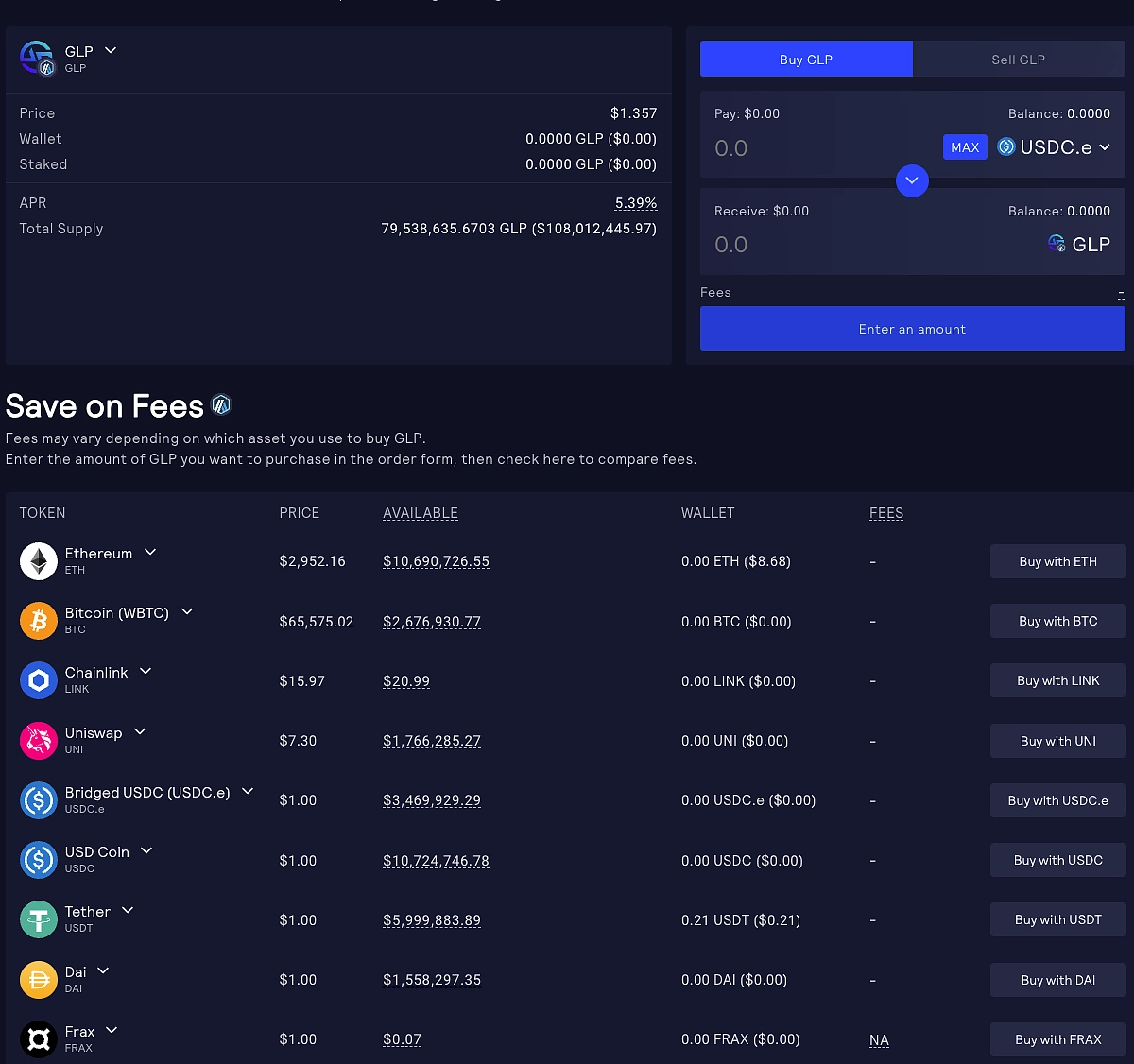
Jupiter
Jupiter is a popular liquidity aggregator on the Solana blockchain, known for providing optimal trading routes across various decentralized exchanges (DEXs) on Solana. Jupiter Liquidity Pools (JLP) refer to liquidity pools created and used by Jupiter to facilitate efficient trading.
In contrast to holding GLP, JLP has a smaller number of underlying pools, with only five assets compared to nine in GLP. JLP currently yields holders up to 80%-120% APY as it receives 70% of fees generated from perps trading activities.
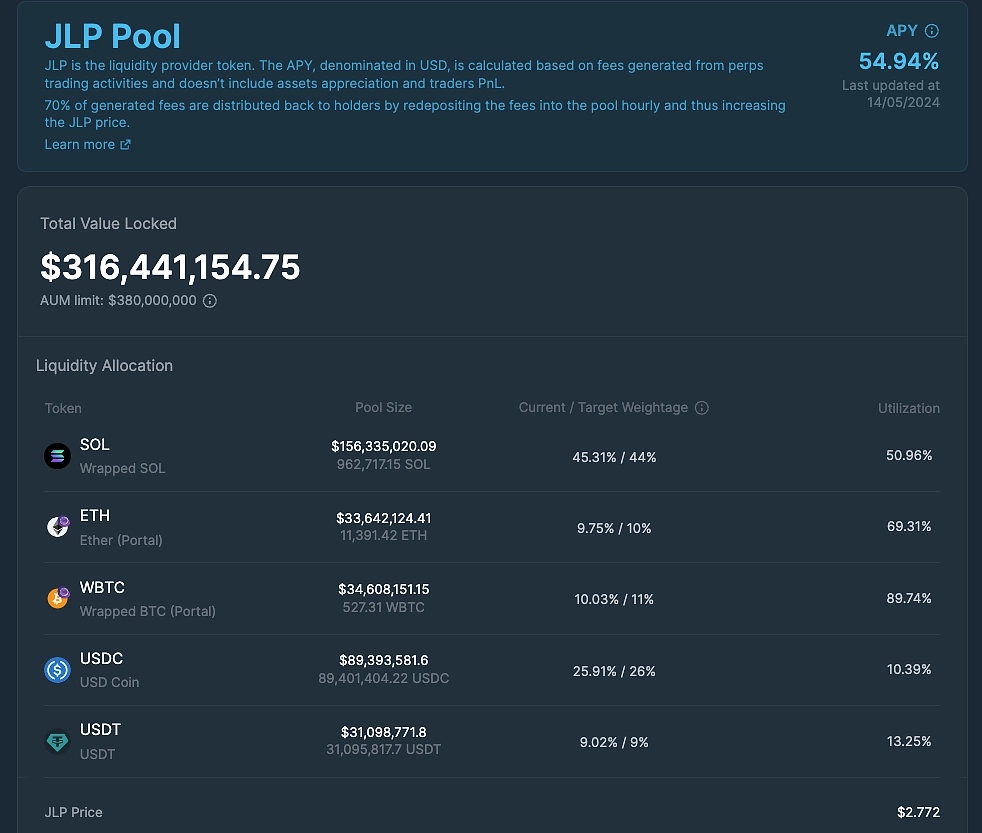
Allocation into an LP position might not yield participants the highest but poses an alternative way for getting exposure to the broader crypto markets during an upward rally. Although GLP and JLP holders may not outperform holding SOL, ETH, or BTC in a bull market, they tend to be resilient, especially in bearish market conditions.
2. Intents Based Architecture
The current state of DeFi is often regarded as complex and time-intensive, requiring users to navigate and execute transactions across various platforms and infrastructures. Traditionally, transactions specify “how” an action should be executed. In contrast, intent-based systems define “what” the desired outcome of an action should be.
With intent-based systems, users can simply specify desired outcomes without needing to detail every transaction parameter. This contrasts sharply with the traditional transaction model, which requires users to explicitly define each aspect of their transactions.
For example, a traditional swap transaction might look like this: Swap 1 ETH for at least 3700 USDC on the USDC-ETH pool on Uniswap with a maximum slippage of 2%.
An intent-based transaction, on the other hand, focuses on the outcome and requires a solver to determine the best way to achieve it. It might look like this: Intent: I want to get as much USDC as possible by selling 1 ETH.
The intent-based architecture will get users the best deal in the market without needing to specify the platform for the swap or the time frame for execution. Users are spared from detailing every transaction parameter and navigating technical complexities, making the process more user-friendly and efficient.
In the crypto landscape today, onboarding the next billion will be a tall order largely due to UI/UX challenges. The cumbersome nature of creating a wallet, transactions through a bridge, and doing swaps on-chain are all factors in dissuading the masses. The idea of intent is to abstract away all the difficulty and give users the best possible outcome in what they are looking for in crypto.
UniswapX
UniswapX is an example of an intent-based protocol designed to overcome the challenge of inefficient routing across fragmented liquidity pools. It is an auction-based protocol where users can find the best price for their trades across Automated Market Makers (AMMs) and various on/off-chain liquidity sources. While the front end of UniswapX appears largely similar to Uniswap, the key differences lie in the back end. Instead of users approving transactions traditionally, their signatures are processed through UniswapX’s Filler network, which finds the best price across centralized exchanges, Uniswap pools, and DEX aggregators.
Aperture Finance
Aperture Finance is utilizing AI-powered intents to streamline the complexities of DeFi. Built atop of Uniswap V3, Aperture enables users to express their end goal for their LP position, which will only be executed if it matches the user’s desired outcome. Additionally, Aperture intends to enhance its Large Language Model (LLM) interface to translate user intents, expressed in natural language, into a domain-specific language (DSL) suitable for on-chain implementation.
Intents could be the key to attracting new participants to DeFi and the broader crypto space by simplifying complex jargon and instruments and making them more accessible. By simplifying interactions, optimizing processes, and promoting broader adoption, intent-based architecture will make it easy and more effective for a wider range of clientele.
3. The Points and Airdrop Meta
Airdrops are widely employed in DeFi to stimulate user participation and liquidity. They help in building communities and spreading awareness about new projects. For instance, the Compound airdrop in 2020, which distributed COMP tokens to users, set a precedent that many other DeFi projects followed. This strategy helps projects bootstrap liquidity and user communities, while also distributing governance powers to users to participate in the future of the project.
Blur
Blur, an NFT aggregator platform, conducted a $450 million airdrop of BLUR tokens based on user engagement. This strategic distribution not only boosted the platform's liquidity but also attracted significant interest from crypto airdrop farmers, who actively participate in such events to maximize their holdings. By introducing Blur points as a way to incentivise user engagements such as listing and bidding of NFTs, these points can be accumulated and are often used to determine user rankings, which qualify them for the token airdrop. Blur ensured the tokens were given to those most likely to utilize them, enhancing the platform's overall utility and adoption while increasing trading activity and visibility within the NFT and broader crypto community.
EigenLayer
EigenLayer is a protocol built on top of Ethereum and introduces restaking. It enables ETH to secure third partner protocols and is designed to provide security services with node operators expected to receive a portion of the fees as service payments. Users earn EigenPoints by staking, providing liquidity, and participating in governance decisions, with points calculated based on the time-integrated amount staked in ETH hours. This approach has attracted over $15 billion in Total Value Locked (TVL), where the accumulated EigenPoints determine eligibility and allocation for the platform's native token airdrop. This method promotes a decentralized and engaged community, increasing the utility and adoption of EigenLayer's services while fostering a healthy ecosystem of users and contributors.
Ethena
Ethena is a stablecoin platform on the Ethereum blockchain which utilizes ETH as collateral through a process called delta-hedging. By launching a points-based program called the "Shard Campaign'' in February 2024 to incentivize user engagement, participants earn Shards by providing liquidity and staking Ethena’s synthetic dollar, USDe, in various DeFi protocols such as Curve and Pendle. These Shards are later converted into allocations of Ethena’s native token, ENA, which launched with a market cap of $1 billion. As of now, over $1.6 billion worth of USDe has been minted, reflecting significant user engagement. This points-based approach not only promotes continuous participation but also fosters a decentralized and active community, contributing to Ethena's growing ecosystem with a Total Value Locked (TVL) surpassing $1.3 billion.
Solana’s Saga Smartphone
In a similar vein, Solana's Saga smartphone, designed with blockchain principles at its core, has leveraged airdrops to attract and reward users. For instance, Saga phone owners received 30 million BONK tokens, significantly boosting the phone's perceived value and driving a surge in sales. Additionally, other airdrops, such as 100,000 ACS tokens from Access Protocol and unique NFTs from the Saga Monkes project, further enhanced the attractiveness of owning a Saga phone, leading to high resale values on secondary markets.
Celestia
Similarly, Celestia, a modular blockchain network, launched a significant airdrop of 60 million TIA tokens in 2024 through its Genesis Drop. This airdrop targeted developers and on-chain addresses on Ethereum rollups, Cosmos Hub, and Osmosis, inviting 7,579 developers and 576,653 on-chain addresses to participate. Eligibility was based on specific criteria, such as being active users of top Ethereum rollups or stakers on Cosmos Hub and Osmosis with a minimum balance. The airdrop aimed to foster community engagement and support the network's growth by distributing tokens to early adopters and contributors, enhancing Celestia's security and scalability. Unclaimed tokens were reallocated to active participants, ensuring comprehensive distribution within the ecosystem.
Airdrops are strategically used to create awareness, build communities, and kickstart token markets, often rewarding users for their interactions and contributions to the ecosystem. As the crypto space continues to grow, airdrops will likely remain a key tool for projects to attract and retain users.
4. Liquid Staking Protocols
Liquid staking protocols represent an advancement in traditional staking mechanisms by enabling stakers to retain liquidity while their assets are locked in staking. This is achieved through the issuance of liquid staking tokens (LSTs), which act as derivatives of the staked assets. These tokens can be utilized in various DeFi activities, enhancing capital efficiency and flexibility.
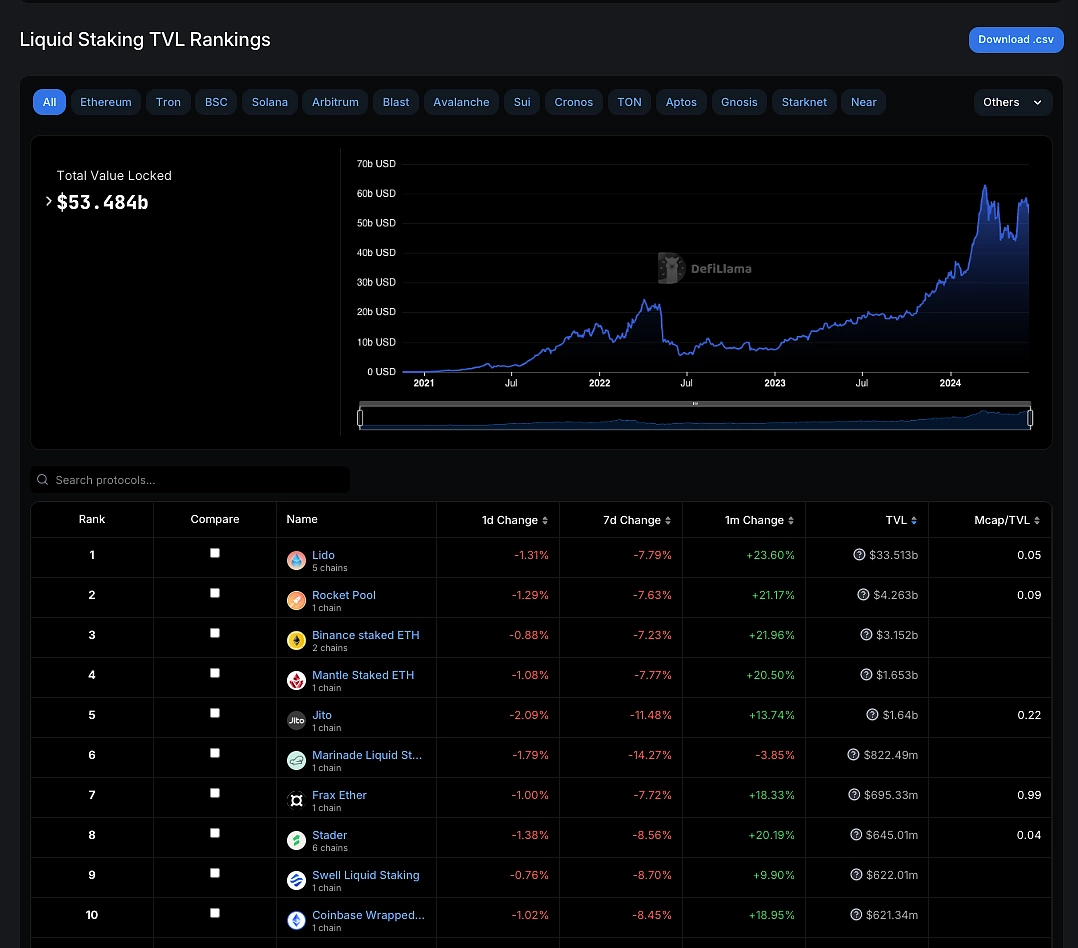
Lido Finance
Lido Finance is the largest and most popular liquid staking platform, supporting multiple networks including Ethereum, Polygon, and Solana. Users can stake their tokens and receive liquid staking tokens (stETH, stMATIC, stSOL) in return, which can be used across various DeFi platforms. Lido holds over $14 billion in total value locked (TVL) and charges a 10% fee on staking rewards. It offers an APY ranging from 4.4% to 6.7% depending on the network
When users stake their assets in a liquid staking protocol, they receive LSTs equivalent to the value of their staked assets. For example, when ETH is staked on Lido, users receive stETH tokens in return. These tokens are pegged to the underlying staked assets, maintaining a 1:1 ratio. LSTs can be used in various DeFi applications, including lending, borrowing, yield farming, and liquidity provision, meaning that while the original assets are earning staking rewards, the LSTs can simultaneously generate additional yield in the DeFi ecosystem. This dual utility maximizes the potential returns on staked assets and allows for more dynamic investment strategies.
The technology behind liquid staking involves smart contracts, which automate the staking process, mint LSTs, distribute rewards, and ensure security. These contracts are often audited to prevent vulnerabilities and ensure the integrity of the staking process. Protocols like Frax Finance use Algorithmic Market Operations (AMO) to maintain the price stability of their liquid staking tokens, ensuring that the LSTs closely track the value of the underlying assets. Additionally, many liquid staking protocols utilize decentralized autonomous organizations (DAOs) for governance. Token holders can vote on protocol changes, fee structures, and other important decisions, ensuring that the platform evolves in line with the community’s interests.
LSTs provide stakers with the opportunity to earn additional yields through DeFi strategies such as yield farming and liquidity provision, making staking more attractive and lucrative. While liquid staking introduces new risks, such as smart contract vulnerabilities and counterparty risk, many protocols implement robust security measures, including regular audits and decentralized governance models, to mitigate these risks.
Restaking
Emerging trends include the rise of restaking protocols like EigenLayer, which offers Liquid Restaking Tokens (LRTs) for additional yield opportunities, and the expansion into Layer 2 solutions with initiatives like Metis's Liquid Staking Blitz. These developments, along with the potential regulatory approval of Ethereum spot ETFs, are expected to drive further adoption and integration of liquid staking protocols. As the DeFi ecosystem continues to evolve, liquid staking is set to remain a dynamic and rapidly growing sector, offering enhanced liquidity, capital efficiency, and yield opportunities for participants.
5. Cross Chain Bridging
The advent of cross-chain interoperability enables seamless transactions and asset transfers across various blockchain networks. According to L2Beat, bridges have a Total Value Locked (TVL) of over $9 billion, demonstrating the significant impact and growing adoption in this sector.
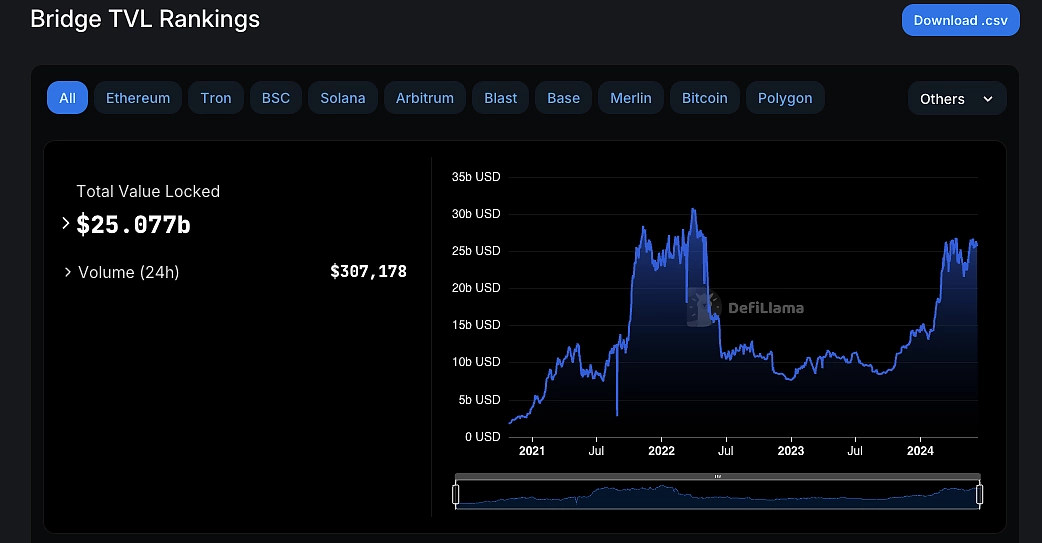
Through cross-chain protocols, users can access a wider range of DeFi services beyond the limitations of a single blockchain, thereby opening new avenues from decentralized lending and trading to asset management and yield farming.
Axelar
Axelar bridge is one example that is designed to connect multiple blockchain networks. It operates with the Hub and Spoke model where Axelar acts as a central hub, connecting various blockchains (spokes). With over 25 chains integrated, DeFi protocols can leverage liquidity across chains, offering users better rates and more options for lending, borrowing and trading. Protocols like Sommelier leverage Axelar to run yield strategies across different networks, optimizing returns for users. Additionally, JPMorgan’s Onyx Digital Assets leverages Axelar for managing tokenized assets, showcasing the protocol's ability to support large-scale financial operations.
Hyperlane
An alternative to the Hub and Spoke model, Hyperlane focuses on modularity and permissionless interoperability. It allows developers to deploy the protocol without needing approval from a central authority, decentralized applications (dApps) need not rely on a central hub but communicate directly from one dApp to another, allowing for greater customizability and decentralized control. Their integration with Celestia allows for cross-chain transfers of TIA between rollups.
Chainlink’s CCIP
Additionally, Chainlink's Cross-Chain Interoperability Protocol (CCIP) enhances the DeFi ecosystem by enabling cross-chain liquidity pools and interoperable DeFi protocols. By allowing liquidity pools to span multiple blockchains, CCIP significantly improves liquidity and trading opportunities, reducing slippage, improving trade execution, and offering better prices for traders. Additionally, CCIP facilitates the seamless interaction of DeFi applications across various networks, enabling protocols to leverage the unique features and benefits of each blockchain. For instance, a lending protocol can utilize Ethereum's high liquidity while benefiting from the low transaction fees of a Layer 2 solution like Polygon, resulting in more efficient, scalable, and cost-effective services that enhance overall functionality and user experience.
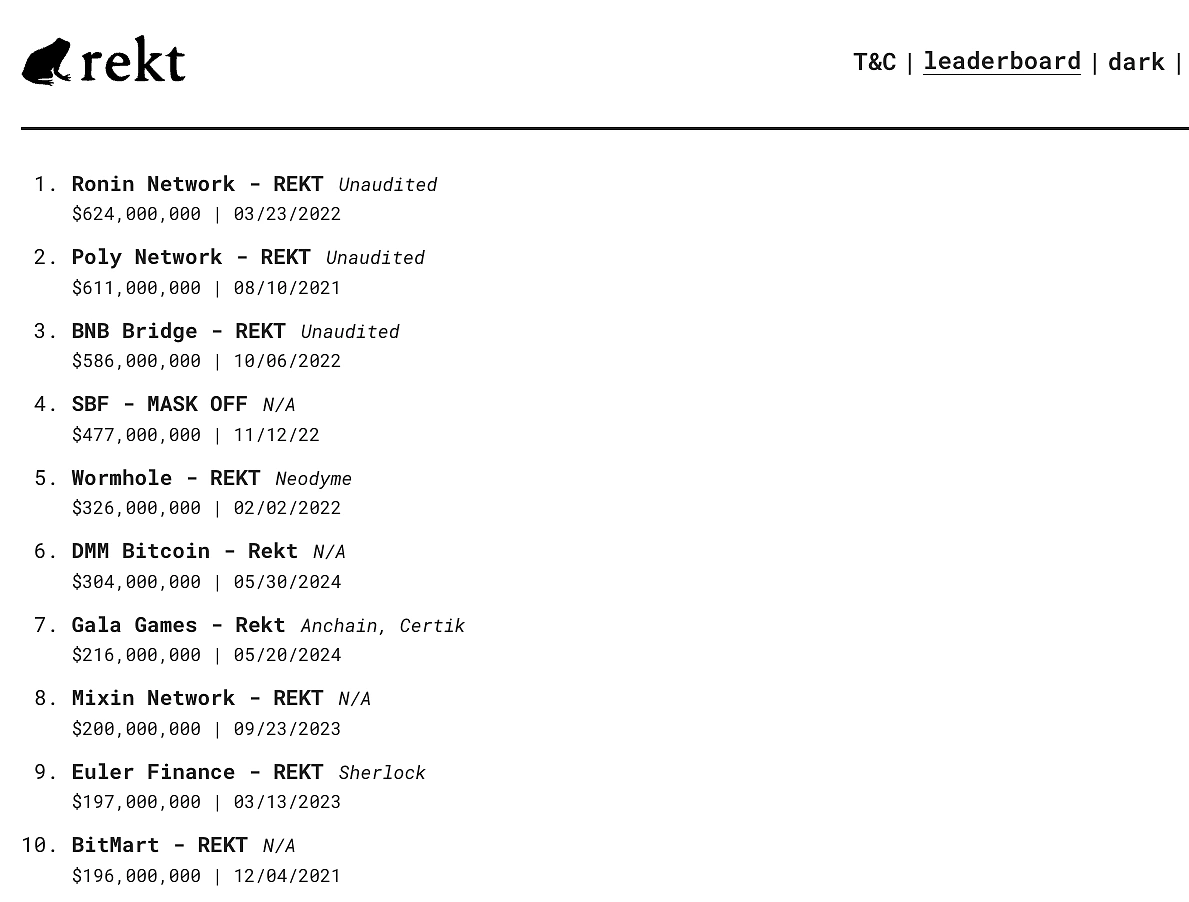
While five of the ten largest hacks in Web3 have originated from bridge exploits as seen above, many protocols are now prioritizing security and risk management. Kima Protocol, in particular, emphasizes security by leveraging decentralized liquidity pools, native wallet accounts, and AI-driven liquidity management. By using hardware-based security measures and avoiding smart contracts, oracles, and external relayers, Kima aims to significantly reduce the risk of hacks and security breaches.
5. Real-World Assets
Real World Assets (RWA) tokenization involves transforming physical assets into digital tokens or NFTs, facilitating their trade on blockchain networks. This process introduces opportunities for investors and establishes a connection between conventional and digital economies. RWAs hold promise in providing stable yields, appealing to investors seeking diversification into reliable income streams. Additionally, they promote global market participation by eliminating geographical constraints and reducing entry barriers.
With the collapse of FTX, Luna and 3AC in 2022, many turn to the RWA sector as a safe haven to store their assets in crypto. According to CoinGecko’s report on the Rise of Real Word Assets in Crypto, 2023 saw a massive increase in inflow of tokenized treasuries by 782%, as the Total Value Locked (TVL) raised from $104 million in January 2023 to $917 million by the conclusion of 2023.
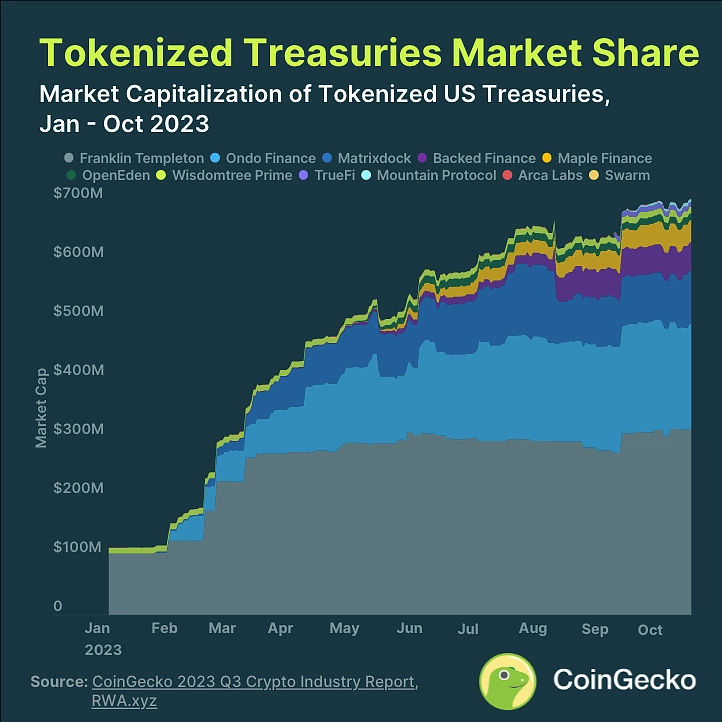
Realio
Realio network is an interoperable Layer 1 that supports real-world asset management with open-source and permissionless infrastructure. Built on the Cosmos SDK, Realio operates using two tokens: the Realio Network Token (RIO) and the Realio Security Token (RST), and also features Ethereum Virtual Machine (EVM) compatibility. Through tokenization, they plan to bring RWAs onto the blockchain where users can tokenize their physical or non-digital assets to be represented as digital tokens. Realio enables them to be bought, sold, and/or traded on digital platforms after being put through their legal framework, ensuring assets are compliant with KYC/AML laws and securities regulations.
Ondo Finance
Ondo Finance (ONDO) is another RWA project, which is one of the largest players in the $1.2 billion tokenized treasury market. They are focused on bringing institutional-grade money into the crypto space via Tokenizing T-Bills for yield with their USDY stablecoin. Over the past months, there has been notable growth with its TVL peaking at $420 million, a 959% increase from 39.22 million in March 2023. Notably, Ondo Finance has secured backing from major players such as Pantera Capital, Coinbase, and Blackrock.
Swarm
Swarm markets is a decentralized trading platform that allows institutional investors to trade and stake tokens based on RWA such as commodities or financial securities. They are regulated by the German financial authority and allow asset issuers to create token and liquidity pools directly on the platform. Users can purchase popular United States stocks such as NVDA, COIN, MSFT, TSLA and directly participate in DeFi pools on the platform on the Polygon network allowing for greater access to the global markets.
While Real World Assets (RWA) may encounter hurdles in garnering adoption due to perceived risks and regulatory ambiguity, numerous projects are emphasizing regulatory compliance. As the sector progresses and matures, RWA persists as a significant opportunity to reshape traditional finance and introduce novel investment avenues. It stands as a noteworthy DeFi trend to monitor throughout the remainder of 2024.
6. A New Layer for Bitcoin
DeFi on Bitcoin is evolving, driven by the development and adoption of Bitcoin Layer 2 solutions. These advancements are enabling the creation of decentralized applications (DApps) on the Bitcoin network, overcoming previous constraints of Bitcoin’s scripting capabilities.
Lightning Network
The Lightning Network facilitates instant and low-cost Bitcoin transactions through off-chain payment channels. This technology is crucial for enabling micro-transactions and increasing Bitcoin’s transaction throughput. As of 2024, the Lightning Network processes approximately 5,000 transactions per second (TPS), significantly more than Bitcoin’s base layer capacity of around 7 TPS. The network's capacity has grown to over 4,200 BTC, valued at over $100 million, indicating substantial adoption.
Stacks
Stacks brings Turing-complete smart contracts to Bitcoin through its proof-of-transfer consensus mechanism. This allows developers to build DApps directly linked to the Bitcoin blockchain. Notable projects on Stacks include Stackswap, a decentralized exchange, Arkadiko, a DeFi lending platform, and CityCoins, a civic engagement and reward system. Stacks’ market capitalization has grown to over $1 billion, with more than 300 DApps developed on its platform.
RSK
RSK operates as a Bitcoin sidechain, enabling smart contract functionality through merged mining with Bitcoin. This ensures high security while allowing the execution of complex DeFi applications. RSK hosts several DeFi projects, including Sovryn and Money on Chain. The RSK network has locked over 1,500 BTC, worth approximately $40 million.
Liquid Network
Developed by Blockstream, the Liquid Network offers fast and confidential transactions, issuance of digital assets, and support for smart contracts. Liquid Bitcoin (L-BTC) is used within the network to facilitate these functionalities. The Liquid Network handles over 10,000 transactions daily, with a total transaction volume exceeding $2 billion since its inception.
Emerging trends include the introduction of BRC-20 tokens, enabling fungible token creation on Bitcoin, similar to Ethereum’s ERC-20 standard. This development is attracting developers to build DeFi applications utilizing Bitcoin’s security. Protocols like RSK and Stacks provide compatibility with the Ethereum Virtual Machine (EVM), allowing developers to port Ethereum-based DApps to the Bitcoin ecosystem. This compatibility has led to over 200 Ethereum dApps being adapted for use on Bitcoin.
The development of DeFi on Bitcoin, particularly through Layer 2 solutions, is transforming the ecosystem. Developers are building sophisticated dApps that leverage Bitcoin’s security and these advanced technologies to bring DeFi functionalities to Bitcoin holders. The total value locked (TVL) in Bitcoin DeFi projects has surpassed $1 billion, reflecting growing participation in Bitcoin-based DeFi solutions. As these Layer 2 solutions evolve, they will play a crucial role in expanding Bitcoin’s capabilities, driving innovation, and solidifying its position in the DeFi landscape.
7. Prediction Markets
Prediction markets, where users trade and speculate on future events, have historically struggled to gain significant attention or capital in the DeFi ecosystem due to regulatory challenges and the difficulty of achieving the right product-market fit. However, recent data suggests that these markets are gaining momentum, with total value locked (TVL) reaching $55.1 million in early 2024, a 57.7% increase year-to-date. This growth indicates that prediction markets might be finally finding their footing within DeFi.
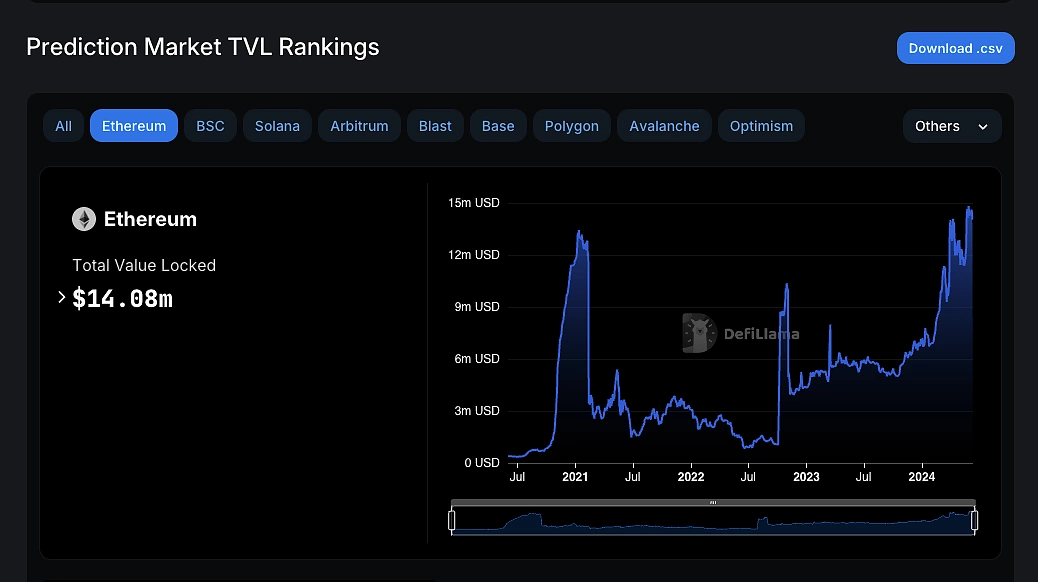
Major events drive demand for prediction markets, and 2024 is a significant year with elections in eight of the ten most populous nations, including the highly anticipated U.S. Presidential election. These events create opportunities for speculation, contributing to the growth of prediction markets and their integration into the broader DeFi landscape. Prediction markets leverage the wisdom of crowds to aggregate predictions, which can theoretically reduce information asymmetry and align market odds with actual outcomes. This enhances data quality, news accuracy, and public discourse.
Polymarket
Polymarket, built on Polygon, stands out as a leading on-chain prediction market. It has seen substantial growth in 2024, with average monthly trading volumes rising from $6.1 million in 2023 to $42.0 million. This growth is highlighted by Polymarket's trading activity and its recent $45 million Series B funding round, bringing its total funding to $70 million. The increase in trading volumes and active user base, from 1,600 at the end of 2023 to 3,800 in 2024, indicates a solidifying presence within the DeFi ecosystem.
Polymarket covers a wide range of topics, allowing users to speculate on various categories, including sports, politics, and pop culture. The number of open markets has increased, with the percentage of active markets rising from 0.32% to 0.37% in 2024. This diversity enriches the DeFi space by offering more engagement avenues for users.
The current market upswing has brought more users and liquidity to Polymarket, laying a strong foundation for future growth. Historically, Polymarket has generated significant traction from political events, accumulating over $50 million in volumes from the previous U.S. election. With over $128 million already bet on the upcoming election, Polymarket is well-positioned to capitalize on this interest, further integrating prediction markets into the DeFi framework.
The 2024 U.S. Presidential election and upcoming UEFA Euro Cup 2024 present a significant opportunity for Polymarket to cement its position as a leading prediction market in DeFi. As Polymarket grows, it will play a crucial role in integrating prediction markets into the broader DeFi ecosystem, offering valuable insights into collective expectations. Leveraging blockchain technology for transparency and security, Polymarket boosts user engagement and contributes to DeFi's overall growth and innovation.
Summary
DeFi is at a pivotal moment, gaining traction in both major and niche markets due to new developments and narratives. The sector is evolving, building on the foundation of early areas like DEXes to offer previously inaccessible financial primitives on-chain.
The growing importance of these new markets is clear as the push for expanded on-chain presence increases. Recent market uptrends and developments like spot ETF approvals and asset tokenization are attracting more institutional liquidity and participation. This shows the need for the DeFi ecosystem to provide tools that meet diverse market demands and retain new demand and liquidity on-chain.
Emerging markets are introducing new types of derivatives, innovative on-chain yield paradigms, CEX-like trading products, and more capital-efficient lending designs. These innovations improve efficiency in decentralized markets and bridge the gap between DeFi and TradFi.
Despite the positive outlook, challenges such as liquidity fragmentation, composability, and user experience hinder widespread adoption. Additionally, new technologies bring inherent risks.
As these markets mature, we expect a shift towards a more consolidated market structure centered around a few dominant approaches. Over the next year, DeFi will likely continue to change, evolving significantly from its early iterations. The rapid pace of innovation suggests that the next generation of financial primitives is on the horizon. It will be interesting to see which markets and protocols thrive in the long term.

Subscribe to the CoinGecko Daily Newsletter!






 Or check it out in the app stores
Or check it out in the app stores
